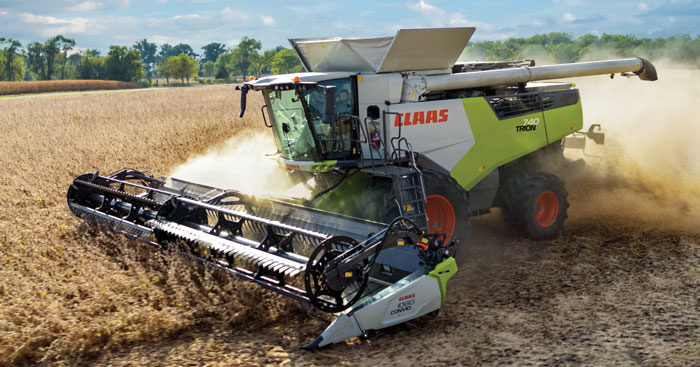Fast Facts
Customer Segment: Farmers with 1,000-3,000 acres looking for high throughput
Key Selling Point: Minimal grain loss at high throughput levels
Claas announced the launch of its newest combine, the TRION 740, on June 15, calling it, “newly designed to provide small to mid-sized operators a competitive edge.”
The TRION 740 was designed for the 1,000- to 3,000-acre farmer, who make up over 30% of all combines sold in North America. It offers long greasing intervals and extended wear parts across 60% of the crop flow to minimize downtime, as well as active slope compensation and minimal fuel consumption. Greg Frenzel, product manager – combines, at Claas, said at the 740’s launch that the TRION 740 averaged 1.15 gallons of fuel per acre in fall 2021 vs. 1.58 per acre for its competitors, based on the company’s internal class 7 combine studies.
Threshing adjustments are made in-line with the changing harvest conditions throughout the day. A tri-cylinder APS threshing unit guides a 56-inch-wide crop mat across concave grates into a single rotor, ensuring more grain makes it to the tank.
“The latest innovations in harvesting have been high throughput machines with features for the largest operators in the market. The class 7 market has largely been left behind,” says Frenzel. “We even saw displeased responses to those announcements, with farmers calling for reliability and affordability during a time when the focus was on capacity and throughput. Over 5 years of infield validation with the TRION 740 delivers that reliability class 7 owners have been asking for.”
Frenzel highlights the 740’s 0.5% grain loss vs. the competitions 1.5% grain loss and adds the combine experiences minimal grain loss at even high throughput levels.
“When harvesting soybeans, the APS hybrid threshing system and single separation rotor does a better job of keeping the seed coat intact at typical harvest speeds,” he says. “Additionally, very limited grain loss at high throughput levels keeps more grain in the combine than the competition. Independent threshing and separation systems allow customers to fine tune performance for any harvest condition.”







Post a comment
Report Abusive Comment